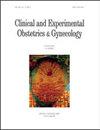病态肥胖患者经阴道同时行子宫切除术和脐疝修补术
IF 0.6
4区 医学
Q4 OBSTETRICS & GYNECOLOGY
引用次数: 1
摘要
背景:脐疝在超重、多胎妇女中尤为常见。腹腔镜疝修补术是首选的,因为它有很多优点。另一方面,套管针部位疝的风险是不利的。Trocar不会通过经阴道的自然孔腔内内镜手术(V-NOTES)穿过腹壁。我们研究了V-NOTES子宫切除术和伴发脐疝修补术的可行性和结果。方法:在2020年4月至2021年1月期间,6名病态肥胖患者接受了V-NOTES子宫切除术和并发脐疝修补术。记录患者的人口学特征、手术时间、疝大小、并发症、住院时间、疝复发、第6、第12和第24小时、第1、第4、第12周和第6个月的视觉模拟评分(VAS)。结果:患者平均年龄为47.667±2.422(45-52)岁。平均体重指数(BMI)、疝气和手术时间分别为44.367±3.217 kg/m(40.3–48.5)、6.167±1.722 cm(4–9)和88±12.791分钟(75–110)。没有发生术中并发症。在一名患者(16.6%)中检测到血清瘤。在六个月的随访期间,我们没有确定疝复发和术后慢性疼痛的诊断。结论:我们的研究为V-NOTES脐疝修补术和子宫切除术治疗病态肥胖患者提供了一个新的视角。根据我们的研究,在高危患者群体中进行V-NOTES脐疝修补术是可行的,并且具有良好的效果。本文章由计算机程序翻译,如有差异,请以英文原文为准。
Concurrent hysterectomy and umbilical hernia repair via transvaginal notes among morbidly obese patients
Background: Umbilical hernias are especially common along with overweight, multiparous women. Laparoscopic hernia repair is preferred due to many advantages. On the other hand, the risk of trocar site hernia is disadvantageous. Trocars do not go through the abdominal wall via transvaginal natural orifice transluminal endoscopic surgery (V-NOTES). We investigate the V-NOTES hysterectomy and concomitant umbilical hernia repairment feasibility and outcomes. Methods: Six morbidly obese patients underwent V-NOTES hysterectomy and concurrent umbilical hernia repair between April 2020 and January 2021. Demographic features of patients, operating time, hernia size, complications, hospitalization time, recurrence of the hernia, visual analog scale (VAS) at 6th, 12th, and 24th hours, first, fourth, 12th weeks, and sixth months were recorded. Results: The average age of patients was 47.667 ± 2.422 (45–52). Mean body mass index (BMI), hernia and operating time size were 44.367 ± 3.217 kg/m (40.3–48.5), 6.167 ± 1.722 cm (4–9) and 88 ± 12.791 minutes (75–110), respectively. Intraoperative complications did not occur. Seroma was detected in one patient(16.6%). In six month follow-up period, we did not establish a diagnosis of hernia recurrence and postoperative chronic pain. Conclusion: Our study offers a novel perspective on V-NOTES umbilical hernia repair and hysterectomy in morbidly obese patients. According to our study, performing V-NOTES umbilical hernia repairment in a risky patient population is feasible and has promising outcomes.
求助全文
通过发布文献求助,成功后即可免费获取论文全文。
去求助
来源期刊
CiteScore
0.50
自引率
0.00%
发文量
241
审稿时长
1 months
期刊介绍:
CEOG is an international, peer-reviewed, open access journal. CEOG covers all aspects of Obstetrics and Gynecology, including obstetrics, prenatal diagnosis, maternal-fetal medicine, perinatology, general gynecology, gynecologic oncology, uro-gynecology, reproductive medicine, infertility, reproductive endocrinology, sexual medicine. All submissions of cutting-edge advances of medical research in the area of women''s health worldwide are encouraged.

 求助内容:
求助内容: 应助结果提醒方式:
应助结果提醒方式:


